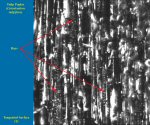Tulip Poplar/Yellow Poplar
  The genus Liriodendron is composed of two species, (L.
tulipifera) (Yellow poplar from North America and L.
chinensis from China). Both species are identical at the
cellular level.
The genus Liriodendron is composed of two species, (L.
tulipifera) (Yellow poplar from North America and L.
chinensis from China). Both species are identical at the
cellular level.
 Tulip
Poplar is native to the eastern United States. The trees reach
heights of 160 ft with diameters of 8 ft. The of Tulip Poplar
sapwood is white and heartwood is a light brown, but can range
in color (especially after exposure to air and time) from greenish
brown to dark green, purple, black, blue and yellow. The wood
of Tulip Poplar has a straight grain, with a uniform texture and
light weight. It is below average in specific gravity and most
physical and mechanical properties. Tulip poplar is one of the
easiest of all hardwoods to work by hand and with machine tools.
It is used for dimension stock, furniture, gunstocks, hat blocks,
interior finish, lumber, musical instruments, novelties, pallets,
particle board, plywood, pulpwood, shipping crates, slack cooperage,
sporting goods, toys and veneer. Tulip
Poplar is native to the eastern United States. The trees reach
heights of 160 ft with diameters of 8 ft. The of Tulip Poplar
sapwood is white and heartwood is a light brown, but can range
in color (especially after exposure to air and time) from greenish
brown to dark green, purple, black, blue and yellow. The wood
of Tulip Poplar has a straight grain, with a uniform texture and
light weight. It is below average in specific gravity and most
physical and mechanical properties. Tulip poplar is one of the
easiest of all hardwoods to work by hand and with machine tools.
It is used for dimension stock, furniture, gunstocks, hat blocks,
interior finish, lumber, musical instruments, novelties, pallets,
particle board, plywood, pulpwood, shipping crates, slack cooperage,
sporting goods, toys and veneer.
http://www.fpl.fs.fed.us/documnts/TechSheets/HardwoodNA/pdf_files/lirioeng.pdf.
Characteristics found in the Tulip Poplar (Liriodendron spp.):
- Diffuse porous
- Scalariform perforations (6-10)
- IV pits medium (8-12)
- Rays 1-4 seriate & heterocellular
WOOD SLIDES
Click on each image to view a larger
image.
  
   
 
   
CHARCOAL SLIDES
  
   
|




 Tulip
Poplar is native to the eastern United States. The trees reach
heights of 160 ft with diameters of 8 ft. The of Tulip Poplar
sapwood is white and heartwood is a light brown, but can range
in color (especially after exposure to air and time) from greenish
brown to dark green, purple, black, blue and yellow. The wood
of Tulip Poplar has a straight grain, with a uniform texture and
light weight. It is below average in specific gravity and most
physical and mechanical properties. Tulip poplar is one of the
easiest of all hardwoods to work by hand and with machine tools.
It is used for dimension stock, furniture, gunstocks, hat blocks,
interior finish, lumber, musical instruments, novelties, pallets,
particle board, plywood, pulpwood, shipping crates, slack cooperage,
sporting goods, toys and veneer.
Tulip
Poplar is native to the eastern United States. The trees reach
heights of 160 ft with diameters of 8 ft. The of Tulip Poplar
sapwood is white and heartwood is a light brown, but can range
in color (especially after exposure to air and time) from greenish
brown to dark green, purple, black, blue and yellow. The wood
of Tulip Poplar has a straight grain, with a uniform texture and
light weight. It is below average in specific gravity and most
physical and mechanical properties. Tulip poplar is one of the
easiest of all hardwoods to work by hand and with machine tools.
It is used for dimension stock, furniture, gunstocks, hat blocks,
interior finish, lumber, musical instruments, novelties, pallets,
particle board, plywood, pulpwood, shipping crates, slack cooperage,
sporting goods, toys and veneer.


















